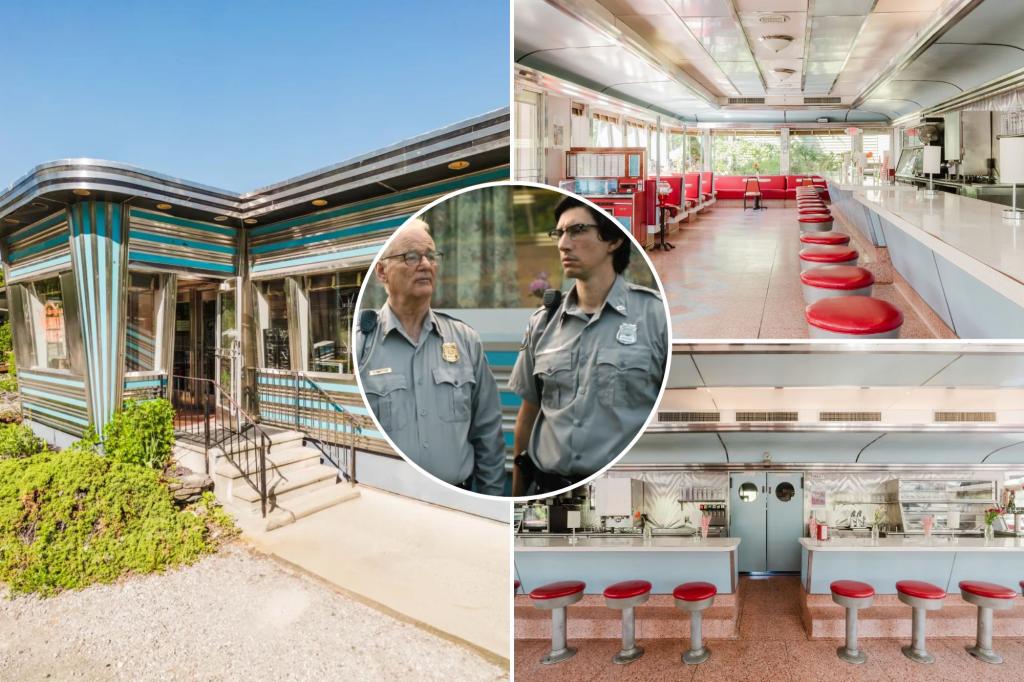Talk about dishing up nostalgia. If the Elizaville Diner & Deli could talk, it would probably ask for a slice of cherry pie and a second take.
This shimmering Hudson Valley roadside relic, with its candy-striped aluminum skin and curved Space Age roof, is not just a feast for the stomach — but also for the lens.
Now listed for $1.2 million, the vintage 1956 Kullman Dutchess diner has become one of the Hudson Valley’s most iconic set pieces, doubling as a time capsule and a business opportunity for the next proprietor with a taste for Americana.
Located in Columbia County’s hamlet of Elizaville, the 2-acre property includes the original prefabricated diner — thought to be the last of its kind still standing — and a separate, renovated deli structure overlooking a spring-fed quarry lake.
Though both buildings are currently closed to the public, the site has continued to attract filmmakers, musicians and brands.
Most notably, it served as the eerie backdrop for Jim Jarmusch’s zombie flick “The Dead Don’t Die,” starring Bill Murray and Selena Gomez, and has made cameos in Apple TV+’s “Brightside” and Rolling Stones-branded content.
“It’s really a beautiful spot,” said Shaina Marron, the Houlihan Lawrence broker handling the listing.
“The owners basically just had a life change and they had to go back to their family … They really did a ton of amazing work on this space and just kind of really taking it to the next level.”
The diner’s story begins far from the Hudson Valley — back in Lebanon, Pennsylvania, where it originally opened as the Eat Well Diner.
Constructed in 1956 by Kullman Dining Car Company, it eventually fell into disrepair and was slated for demolition in the early 2000s to make way for a car dealership. That’s when the former owners stepped in, rescuing the building just days before its scheduled teardown.
“They paid to have it brought up and kind of sited there and then dug out a full foundation and basement,” said Marron. “Typically these diners would have just been on a slab. But this one has a full basement underneath it, which has additional storage and also provides the deck work.”
The relocation in 2005 involved disassembling the diner into three parts and trucking it across state lines — along with 22 counter stools (reportedly dug out from a dirt basement), original booths, Formica-topped tables and even a Jefferson Golden Hour Mystery Clock.
Its smoke-stained brass interiors, once dulled by decades of coffee steam and cigarette smoke, revealed their true colors after restoration: blue and chrome, gleaming like new under the soft glow of retro pendant lighting.
“It’s got a fully functional kitchen and all equipment comes with it. So it’s kind of really ready to roll,” Marron said.
Inside, every detail oozes mid-century charm: terrazzo flooring, red vinyl booths, tabletop jukeboxes and a full-service soda fountain behind the counter.
“It has the majority of the original details … a lot of really gleaming chrome aspects to it,” said Marron.
The companion deli next door offers a checkerboard-tile aesthetic that wouldn’t be out of place in a David Lynch dream sequence. The two buildings are connected through a back passthrough, allowing food service to flow between the diner and the deli’s walk-in coolers and prep area.
The property also includes three bathrooms, ample storage in the cement basement and parking for more than 40 vehicles — making it as functionally viable as it is visually iconic.
Its backyard offers sweeping views of the spring-fed quarry, an unusually scenic feature for a commercial property and a possible setting for outdoor dining and events.
“There’s, I think, a lot of opportunity there to expand it however you see fit,” Marron said. “You could even expand it in a sense, putting a lot of additional seating out back and having some live music.”
Moreover, it all stands in the vicinity of the Hudson Valley’s most prime destinations, such as Rhinebeck, Red Hook, Tivoli and Germantown. Marron refers to the location of the diner as a “sweet center spot.”
Although the diner officially closed in the summer of 2024, it remains open to short-term film rentals and special events.
Marron said that it’s been a magnet for creative productions, and even drew nostalgic attention online when she posted the listing on Instagram.
“One of the commenters wrote that his grandfather used to take him to it in Pennsylvania to go get like cherry pie,” she said.
Since its Hudson Valley debut nearly two decades ago, the diner and deli have served more than just milkshakes — it has dished out memories, style inspiration and even a bit of small-town stardust.
“The chain of ownership has only been four people total,” Marron noted, adding that its history remains remarkably intact. The original design, down to the tabletop jukeboxes, still echoes with the sounds of a bygone era.
“The community would love to see someone keep it as a diner,” she said. “Ultimately it’s up to the next owner to kind of steward it however works best for their needs. But it really is such a unique listing … I think it would be amazing if it could stay.”
Marron believes the time is ripe for diners to make a cultural comeback.
“I grew up on Long Island. Diners were definitely like a way of life,” she said.
“Maybe a real big rise in things like fine dining and the bringing back of people cooking more at home … caused a lull in the middle. But now we’re seeing this rise again where people are looking for these community spots to kind of sit and share either a cup of coffee or breakfast or go back to that nostalgic experience.”
